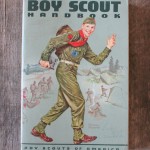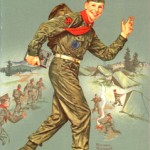Sometimes what is old is new again. The Boy Scout Handbook was first published in 1910 and it has recently been used to turn around a troubled school and transform boys into men.
In a recent episode of 60 Minutes that aired on March 20th, St. Benedicts Prep School in Newark, New Jersey was featured. The school, once a mostly white, prestigious prep school had fallen on hard times. Today the all-boys school is 50% African American and a third Hispanic – with the remainder white. The majority of the student population live in poverty and gangs, violence and drugs rule their neighborhoods. The odds are against these kids.
But here is what is amazing – the drop out rate at St. Benedict’s is only 2 percent (it’s 30 percent in the rest of Newark). 85 percent of the graduates go on to college and graduate from prestigious schools like, Dartmouth, Georgetown and the University of Chicago!
How did this happen? Reverend Edwin D. Leahy – a 1963 graduate of St. Benedict’s – was teaching at the school when the century old institution closed due to inner city rioting. A year later, he spearheaded the efforts to reopen the school, which he felt the community sorely needed and deserved.
With no idea of how to run a school, he found guidance in the Boy Scout Handbook that organizes boys to lead themselves. Today, St. Benedict’s is in essence run like a Boy Scout Troop. The kids run the school.
Rev Leahy spoke about the wisdom he garnered from the Handbook – “We instill and foster leadership and responsibility. From a fellow monk who was a scoutmaster in an earlier life, we have learned not to do for our young men what they can do for themselves. We give our students tremendous responsibility and significant opportunity to serve as leaders in all aspects of school life — from facilitating Convocation, our school-wide morning meeting, to running peer-support groups. And it is not the adults but the students who have the responsibility of promoting positive behavior in living our motto: ‘Whatever hurts my brother hurts me’ — our homegrown rendering of ‘the golden rule’ that the pope has stressed as a guide to justice in all societies. Ultimately, our aim is simple: to help form young men of strong character, not just students who achieve academically.”
As I soaked up the story, I was not only inspired by these students and the faculty around them but also intrigued by how the simple wisdom from the Boy Scout’s Handbook (Michael Bloomberg, Baseball’s Hank Aaron, Astronaut James Lovell and even Keith Richards were Boy Scouts) can be applied in so many aspects of our lives.
Take these Handbook principles that are modeled and honored at St. Benedicts and think for a moment how they could be translated to building leaders in your company or community.
At St. Benedict’s –
- The boys are in charge.
- They make mistakes and learn from them.
- They have traditions that everyone abides by – a simple raise of the right hand signals quiet, for instance.
- Students are organized into groups (patrols) and compete for top grades.
- The team outweighs the individual.
- Upperclassmen lead new students on a four-day, 55-mile hike on the Appalachian Trail each Spring (completing the trail gives you permission to wear the “black hoodie” which is modeled after the monk’s garb. (Let’s face it the Benedictine Monks have been wearing hoodies for many, many years).
- Students are given responsibility early and often.
- They start every day with Convocation – 550 boys in the gym where they sing, pray and embrace one another (yes, really embrace one another). They chant: You can be anything you want to be. Go and conquer!
- Students have each other’s back – they are invested in one another’s success.
At work, what if we:
- Gave employees more responsibility and held them accountable for results?
- Built organization culture through meaningful traditions and rituals?
- Re-enforced teamwork over all?
- Relied more on each other and less on technology?
- Made room for learning from mistakes?
- Committed to building leaders, not workers?

After his first Appalachian Trail hike, one of the students shared that what he learned was “I know now that I not only have to lead myself, I have to lead others.”
Bruce Davis, St. Benedict’s chosen student leader says, “Benedict’s men are different than the guys you see outside, you know every single day. We learn what we’re willing to accept, which is nothing but the best, nothing but finishing what we started.”
Words for us all to live by.






